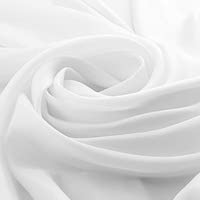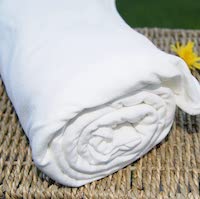Feeling some tie dye vibes? We totally get you. High spirited kids and teens in summer camps are not the only ones nostalgic about it.
Tie dye is timeless, trendy, and darn cute. It has made a major comeback on runways and street fashion lately, and the best part is that you don’t have to stick with pre-made styles you actually hate.
The do-it-yourself fabric craft is super easy. You can tie dye your own material in your favorite palette before sewing it into whatever you like.
But not without the right material. Even experienced crafters can not be complacent about choosing material for tie dye when they are serious about getting brilliant display-worthy results.
So, what fabric can you tie dye at home? Cotton is the best fabric for tie dye, but silk and wool will take the dye well, too. Synthetic materials like rayon and nylon can also be tie dyed well, but acrylic and polyester are more difficult to tie dye at homed without industrial dyes.
Therefore, before going all tie dye crafty to liven up your wardrobe, interior decor, or surprise your friends with colorful gifts, read on.
It is important to explore different materials and how they take tie dye. This article can help you avoid botched tie dye attempts from picking the wrong fabrics.
We’ll tell you the best material for tie dye and also the worst, so you don’t frustrate yourself trying. We also point you to the best fabrics and where you can buy them.
Tie Dye Fabrics – Ranked From Best To Worst
Generally, natural fibers make the best materials for tie dye, but not all can handle specific dyes or the process very well.
So you have to look at the strongest features against drawbacks when weighing your options. Here’s an analysis of fabrics from the best to worst.
Cotton (The Best Fabric For Tie Dye)
Cotton fibers take dye really well, and it is the best material for tie dye. You only need to use a fiber-reactive dye, which is the easiest to use and most effective for cotton.
If you choose to use an all-purpose dye or any dye that requires heating, cotton fabric is still the best due to its heat resistance properties.
There are over 100 types of cotton, and you can choose to work with any you like. However, cotton jersey is among the most popular cotton in the club.
Muslin is also a favorite for crafters being inexpensive, lightweight, and excellent for absorbing dye. You can even go for washed denim or canvas for tie dye bags or upholstery. It’s really up to you.
Linen and hemp make good tie dye fabrics, but they work even better when blended with cotton.
Cotton is a breathable, durable fabric that’s comfortable to wear. Once done, cotton has no problem with heat so you can iron out the creases from the tying, which is a nice bonus!
Rayon
Rayon (which includes most viscose and Tencel fabrics) is unmatched for color intensity surpassing cotton, linen, and hemp for color liveliness. A cold water fiber reactive dye is the best tie dye for it.
The one downside with this kind of fabric is its delicate nature when wet. Rayon can not withstand tension, stress, or abrasion and can be damaged from too much wringing and twisting that comes with tie dying.
If you choose to go ahead with it, hand wash with extra care or use a very gentle machine wash. A rayon cotton blend is, however, more resilient.
Silk
We love silk because it is the most versatile fabric for tie dye. It will work just fine with any dye out there except disperse dyes.
Be it a direct dye, fiber-reactive dye, natural dye, all-purpose dye, or acid dye; silk is not fussy. It also folds exceptionally well for intricate designs.
You only need to give it special care when washing. Like rayon, silk is delicate too. Also, any soda ash dulls its beautiful luster. Synthetic or partially synthetic satin-silk will take tie dye the same way.
Wool
Wool takes tie dye well, as long as you use direct dyes as with any animal protein fiber. The tricky part is folding and tying it into designs due to the bulk of the fabric.
Trying to get wool to go through hot water without shrinking is difficult, which is a major drawback. But that would be a problem for ready to wear articles and not for fabric you will sew afterward.
Still, wool is not the best material for this type of crafting nor as a summer fabric – which tie dye tends to be.
Nylon
Nylon has a unique chemical structure that makes it easy to tie dye. Yes, we know this is surprising especially for synthetic fiber.
You will need an acid dye or disperse dye to do it. Nylon is becoming more popular in clothing, though it hasn’t always been popular (except in hosiery).
Nylon can be used in soft, thin, and somewhat vulnerable items (think tights) or used in things like shower curtains. Still, it’s easy to tie dye, so it’s worth experimenting with!
Acrylic and Polyester (The Worst Fabrics For Tie Dye)
It’s best to reserve these two fabrics for experts who know what they are doing.
Tie dying them is possible, but it’s harder to do. You need special industrial dyes (think toxins) known as disperse dyes. Anything else will wash off – if the fabric will even accept the dye in the first place.
The Best Tie Dye Fabrics You Can Buy
If you’re looking to make and tie dye your items “from scratch” here are the best sewing fabrics you can tie-dye:
| Rank | Product | Description |
|---|---|---|
| 1. | Crafty Cuts Cotton Fabric | 100% cotton, white, 2 sq. yd |
| 2. | Master FAB Cotton Fabric | 100% cotton, white, 2 sq. yd. |
| 3. | Robert Kaufman Muslin Fabric | Muslin/natural cotton, 44" wide, by the yard |
| 4. | Kinderel Organic Bamboo Jersey Knit Fabric | Bamboo (70%) rayon blend, 66" wide, by the yard |
| 5. | Barcelonetta Cotton Lawn Fabric | 100% cotton, white, 58" by 1yd (5 pieces) |
Let’s look at each more closely, shall we?
1. Craftsy Cuts Cotton Fabric
You get 2 yards of woven cotton fabric with a solid white color from Craftsy Cuts, and it’s the perfect background for tie dye.
This fabric, although not as fine as some of the other cottons on this list, is an excellent choice for beginners as it is lightweight, almost sheer, and very flexible to work with.
You will easily be able to create various designs when rolling, twisting, and folding during your tie dye process.
2. Master FAB Cotton Fabric
Our second top pick is 100% combed cotton fabric, poplin woven, and white, from Master FAB.
It has a thread count of about 250 making it lightweight, breathable, and perfect for summer clothing! Your light and summery dyes will be at home in this warm-weather fabric.
Plus, since it’s made of cotton, this fabric is easy to wash and dry, can withstand hot water, and irons out smoothly. White fabric is the easiest to dye, too, so you can get all kinds of color effects on this material.
If you want a high-quality fabric for tie dye clothing you can proudly rock out there, this MasterFab cotton fabric fits the bill.
3. Robert Kaufman Muslin Fabric
If you are an experienced sewer, you already know that Robert Kaufman fabrics do not joke with quality.
Their muslin is of such high quality, it could pass for regular cotton fabric. You can easily make comfy pajamas, lounge clothes, pants, and even summer dresses with this fabric.
Cotton muslin is a favorite among sewing crafters for its soft texture and sheer volume. Its high absorbency makes it fantastic for tie dye. We also loved that it is made in the US and is cut by the yard, so you get one continuous flow of cloth.
Left a natural color, this fabric is great for those looking to keep with natural dyes. Plus, many like to play with dyeing on top of colors other than white. It keeps things fresh.
4. Kinderel Organic Bamboo Jersey Knit Fabric
A 70% bamboo rayon and 30% cotton blend, this jersey knit fabric from Kinderel is a match made in heaven for tie dyed, top quality outfits.
You get the coveted color intensity from rayon, while cotton boosts the fabric’s strength and durability.
This white, silky smooth, and soft premium fabric, this organic blend is OEKO-TEX certified. If you’d like to switch from the 100% woven cotton norm to something different, but still have an easy time with tie dye, this is a great fabric to use.
5. Barcelonetta Cotton Lawn Fabric
This cotton lawn fabric from Barcelonetta is a fine and airy plain weave fabric that is perfect for almost sheer flowy skirts and dresses.
It takes dye as well as any cotton and for a thin and airy fabric it is relatively quite durable, giving you the best of both worlds.
You get five yards of this cotton lawn, which is enough to make some medium sized garments with (depending on your clothing size, the type of garment, pattern, etc.). Still, you get plenty to work with at a time and plenty of beautiful fabric to play around with.
Related- Can You Tie Dye a Cotton-Polyester Blend?
Yes, blends between natural and synthetic fibers such as poly-cotton can be tie dyed, but the higher the synthetic content, the more muted the colors are likely to be.
It’s best to go for 100% natural fabrics or blends with a maximum of about 35% synthetic content.
You can still tie dye a 50-50% or even 60-40% poly-cotton, but it’s just the cotton content that will react with the dye, which can result in faded or pastel colors.
True cotton is the best material for at-home tie dye projects. It accepts color with so much ease. Other natural fibers are good too, but silk and wool will require special dyes made for animal protein fibers.
On the other hand, synthetic fibers like polyester and acrylic have a complex chemical structure that renders their specific tie dye process challenging. They are the worst material for tie dye except for nylon. Some synthetics like rayon, however, fare pretty well.
Before you purchase fabric for tie dye, be sure there are no barriers to dye-fiber bonding, such as special finishes. Look out for anti-stain and wrinkle-resistant properties. Doing a swatch part test before committing your lovely dye to an entire bale of priced fabric can never be overemphasized.
Up Next: How To Set Tie-Dye Without Vinegar





